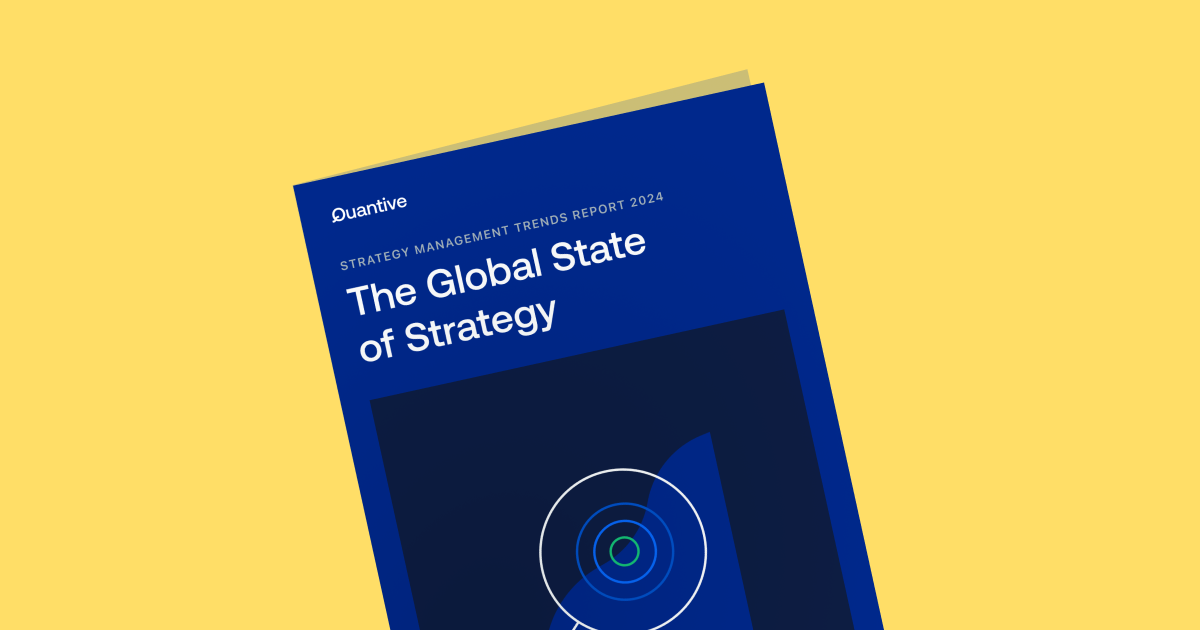Quantive is now part of WorkBoard. Get to know WorkBoard:
What is business adaptability?
Before we begin, let's quickly define adaptability in business.
Business adaptability refers to a company’s ability to quickly respond to market changes, trends, industry shifts, economic disruptions, and other business challenges by adjusting operations to fit the new normal. This requires businesses to hone a specific set of skills, including:
- Agility: Rapidly reacting to changes in the market environment while keeping long-term goals in mind
- Innovation: Continuously building on top of competitive advantages to reach new heights of innovation
- Organizational transparency: Ongoing visibility into strategic priorities and decision-making processes
- Flexible resource deployment: Aptly relaying information and resources when necessary
- Value-driven collaboration: Relevant stakeholders collaborating to drive favorable results
Why is adaptive strategy execution important in business?
To understand why adaptability is important in business, all we need to do is take a quick glance at how the market environment evolved over the past few decades. The increasing pace, severity, and complexity of competitive and environmental challenges are never-ending have been never-ending, making business adaptability a must-have trait in organizations.
Forces such as globalization, technology, and big data are severely impacting how businesses function, while additional market jolts create turbulent business environments. In the past twenty years alone, we’ve experienced:
- The dot-com bubble of 2000
- The financial crisis of 2008
- The COVID-19 pandemic of 2020
With global business challenges occurring more often than we’d like, business adaptability must be tightly embedded within organizations, allowing them to align with industry shifts and remain relevant. Without adaptability in business:
- Decision-making takes weeks instead of minutes
- Employees focus on personal directives instead of company objectives
- Teams are misaligned and create duplicative or conflicting work
A new operational approach to business adaptability
To be successful amidst such large-scale challenges, organizations must leverage a comprehensive business adaptability framework. This involves a novel take on strategy execution — one adaptable enough to maximize engagement, productivity, and coordination whilst fending against obstacles.
“It is not the strongest of the species that survives, not the most intelligent that survives. It is the one that is the most adaptable to change.” - Charles Darwin
This modern business adaptability framework involves establishing agility using adaptive strategy execution. Adaptive strategy execution is a sure-fire way of encouraging flexibility, close communication, and routine operational assessments, ensuring ongoing alignment with internal and external changes.
Before looking at how you can embed this business adaptability framework into your organization, let’s take a closer look at two of its core concepts: the agile framework and adaptive strategy execution.
Understanding agile
The agile methodology is a product management approach initially created for software development projects. It involves a collaborative, iterative, and feedback-driven process to streamline processes, align employees, and improve products continuously.

While agile is now widely adopted by worldwide enterprises such as Apple, IBM, and Google, it didn’t happen overnight. Rather, it rose to success in three distinctive waves of adoption.
- First wave: Agile's growth in individual development teams in the 2000s
- Second wave: Agile at scale in product development and IT in the 2010s
- Third wave: Business agility deployed throughout the modern-day enterprise
Learn more about Agile in full detail

Nowadays, enterprise agility is hailed as a critical driver of innovation, efficiency, and customer engagement. It enables organizations to respond to market changes in a quick, value-focused manner by bringing decision-making closer to customers.
Given the importance of agility in navigating unstable environments for ensuring adaptability in business, your organization must proactively incorporate agility into your business processes. How can you go about doing this holistically?
The fundamentals of adaptive strategy execution
While agility is paramount to adaptability in business, it’s insufficient for creating maximum organizational efficiency. For long-term business adaptability, you must use agile as a steppingstone to a more all-encompassing approach: adaptive strategy execution.
What is strategy execution?
Understanding adaptive strategy execution requires you to first grasp the basics of strategy execution.
Strategy execution is all about ingraining high-level strategic vision into practical, day-to-day execution. It involves creating a plan for your goals and taking actionable steps toward achieving these using available resources.
A well-thought-out strategy execution process entails four steps:
- Planning a cohesive business strategy at the corporate, business, and functional levels
- Aligning individuals across the organization to clearly defined goals
- Executing and managing your strategy at scale
- Assessing and adapting your strategy in line with market changes
Making strategy execution adaptive
Adding the “adaptive” component to strategy execution is achieved through the Modern Operating Model. This model focuses on continuous flexibility, alignment, agility, and cross-functional accessibility using key performance indicators (KPIs) and objectives and key results (OKRs). KPIs are used to run standard operations, while ambitious goal-setting frameworks such as OKRs establish business adaptability and growth.
Read more on the Modern Operating Model

Solidifying adaptive strategy execution with organizational design
To sustain business adaptability, you need a supportive organizational design. In the current knowledge economy, a top-down command and control structure can stop you from attaining adaptability in business — you must strive for flatter, network-based structures. These are necessary for today’s hybrid work environment, facilitating ongoing alignment, coordination, and flexibility for optimal operations, even in a complex context.
The high cost of non-adaptive organizational designs
Sticking to traditional corporate designs can cause (or aggravate) issues within your organization, affecting your ability to attain business adaptability. For example, non-adaptive structures inhibit effective communication, alignment, and employee ownership, leading to disempowered employees and subpar work. As 79% of employees are already disengaged, this can exacerbate pre-existing issues, with non-adaptive designs fueling the fire of misdirected efforts, minimal value creation, and costly turnover.
Using adaptive organizational designs, you can effectively deploy resources in response to market needs and ensure adaptability in business. This motivates employees to address threats, opportunities, and obstacles promptly, subsequently improving engagement, productivity, and business adaptability.
Making adaptive strategy execution a fundamental business competency
Now that we’ve covered the basics of adaptive strategy execution, we’ll look at how you can implement it into your organization to achieve business adaptability.
For starters, you must take a critical look at how value is created within (and across) your business departments. By assessing your operations, you can steer them toward nurturing adaptability in business using agile principles and adaptive strategy execution — turning these into a core competitive advantage for your organization.
Building adaptive resilience with agile
After choosing to prioritize business adaptability, you must understand the individual benefits your business can derive from agility. A great place to start is with a deep, yet limited implementation of agile on a handful of customer-impacting processes or value streams.
A crucial part of this involves leadership clarity on the expected benefits of implementation. That is, you should be able to fill in the blank of “We are optimizing for ____.”
Some examples include:
- Increased value realization
- Increased productivity
- Improved responsiveness and adaptability
- Increased innovation
- Faster time-to-market
- Increased customer responsiveness and satisfaction
- Improved quality
- Improved employee engagement and satisfaction
While you can gain significant benefits from agile, attaining them all at once is rare, and it’s not practical to push for them all at the same time. With this in mind, focus on the most important benefits for your organization, using progress measures to track, align on, and prove success. This will help you get the most out of any adaptive strategic execution program, even in uncertain circumstances.
Discover the impact of an Always-On Strategy on performance

Creating agile OKRs for adaptive strategic execution
To support agile goals and nurture business adaptability, you need a robust goal-setting methodology such as OKRs. OKRs provide actionability to goals while allowing you to make adjustments as needed, boosting business adaptability. As such, they're fundamental to adaptive strategy execution and business adaptability.
Composed of objectives and key results, this methodology encourages you to set trackable, ambitious, and time-bound goals at every level of your organization. Objectives refer to short, qualitative descriptions of what you want to achieve. Each objective is supported by two to four key results, which are trackable metrics depicting progress toward your objectives.
OKRs provide several benefits as you work to establish adaptability in business, enabling:
- Focus: OKRs highlight the most important company goals, improving prioritization amidst market changes
- Accountability: Mandatory OKR ownership ensures everyone knows what goals they’re in charge of
- Alignment: Using clear overarching objectives as guiding lights, departments, teams, and individuals push in the same direction
- Transparency: OKRs' transparency ensures everyone is aware of goal progress
- Engagement: As OKRs encourage visibility around ambitious goals, individuals are empowered to push boundaries and make steady progress toward their goals
- Flexibility: OKRs’ flexible cycle allows them to be adjusted and adapted in response to progress metrics and changes in market environments
Read more benefits of implementing OKRs in business

By using OKRs to establish agile operations, you can leverage unparalleled capabilities, prioritize value-added growth, and work cohesively toward a singular mission – all while accounting for ongoing changes in the business environment.
Leading business adaptability with adaptive strategy execution
Given today’s complex world, you must take it upon yourself to courageously lead, transform, and execute strategy for success to ensure optimal business value. This involves nurturing business adaptability throughout your strategy and structure using adaptive strategy execution.
Weaving agility into your operations strengthens communication, keeps teams flexible, and aligns efforts toward prioritized outcomes as you keep tabs on the market environment.
As OKRs spearhead adaptive strategy execution by helping create, align, and track actionable goals, they're potent accelerators of business adaptability. OKRs encourage the much-needed mindset shift for organizations of all sizes to establish quick decision-making, strategic planning, coordinated ecosystems, adaptive leadership, and flexible strategic management.
If you want to deploy OKRs across your organization, you can leverage a strategy execution platform, making OKR implementation a breeze. The best OKR software helps you create team OKRs, view live data, and continuously adapt OKR elements. Moreover, they can empower efficient operations by establishing goal ownership, generating performance reports, and ensuring visibility at every level of the organization.
Quantive empowers modern organizations to turn their ambitions into reality through strategic agility. It's where strategy, teams, and data come together to drive effective decision-making, streamline execution, and maximize performance.
As your company navigates today’s competitive landscape, you need an Always-On Strategy to continuously bridge the gap between current and desired business outcomes. Quantive brings together the technology, expertise, and passion to transform your strategy and playbooks from a static formulation to a feedback-driven engine for growth.
Whether you’re a fast-growing scale-up, a mid-market business looking to conquer, or a large enterprise looking for innovation, Quantive keeps you ahead – every step of the way. For more information, visit www.quantive.com.





